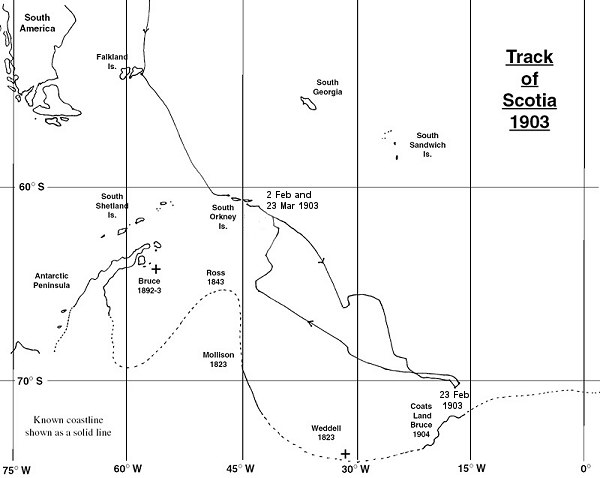
| Glasgow Digital Library | Voyage of the Scotia | BRUCE | PEOPLE | SHIP | ANTARCTIC | INDEX |
|---|
The weather improved as they sailed south. The first sounding, of 1698 fathoms, was taken on 31 January. The bottom was a diatom ooze in which several different minerals were found.
1 fathom = 6 feet (1.8256 metres)
After dodging many icebergs, on 2 February Scotia reached the pack ice at 60°28'S 43°40'W. This was much further north than usual (Ross had met the pack at 65°S). Tight pack ice was found north of the South Orkney Islands. The ship's carpenter (who had helped to rebuild Scotia at Troon) was worried as 'great blocks of ice, many weighing hundreds of tons, rolled, tossed and crashed against each other'.

Weddell and Saddle Island
On 3 February they visited Saddle Island north of Laurie Island in the South Orkney Islands. This island had not been visited since 1838. It was found to be very prolific in bird life including ringed penguins, Cape pigeons (a type of petrel), sheath bills, skuas, giant petrels and shags. A first natural collection of birds, mosses, lichens and insects was made.
The pack ice was three-five metres (10-15 feet) thick, so Scotia sailed east looking for an opening to the south. The pack only thinned out 800km (500 miles) to the east and Scotia, with full sails set, sailed south across the Antarctic Circle at seven knots into a clear sea. They met up with the pack at 69°39'S. Soundings were made of 2,650 fathoms. They reached 71°21'S (Weddell reached 74°15' S in 1823).
The late start from Troon meant the summer season was quickly passing and it was decided to head north. They had intended originally to winter in Enderby Land but the thick pack to the east resulted in a new plan to winter in the South Orkney Islands.
From 26 February to 4 March Scotia battled with the ice until she was out of the main pack. On 11 March she had crossed the Antarctic Circle and was dredging in 700 fathoms. On this occasion the dredge took six hours to put out and bring back in a temperature of -10°C.
On 21 March Scotia was back at the South Orkney Islands. Many of the bays were blocked by ice. Driving snow hid everything and more than once Scotia was almost on the rocks. The rudder of the ship was damaged by collision with a block of ice and it was hanging by one pintle (the rudder is supported by two iron fittings called pintles). Repairs were completed just in time, as an iceberg was moving through the pack towards them.
In hazardous weather, examination was made of two bays shown on their chart. The bays were found not to be suitable and the charts were rather inaccurate. Eventually, while steaming along the south coast of Laurie Island, they entered a wide open bay which narrowed to the north. Mast lookouts watched for rocks and continual soundings were made. Captain Robertson anchored the ship in ten fathoms in what was to be named Scotia Bay. This was to be their winter quarters.

Loss of Antarctic
On 26 February 1903 Larsen's ship, Antarctic, was crushed by the ice and sank 1,280km (800 miles) from Scotia. No radio transmitters were carried at that time so it was many months before Bruce heard of this sinking, by which time the crew had been rescued. At this time Scott in Discovery had just broken out of the ice after being trapped for two years in McMurdo Sound off the Ross Sea (see section 3).
| Glasgow Digital Library | Voyage of the Scotia | BRUCE | PEOPLE | SHIP | ANTARCTIC | INDEX |
|---|